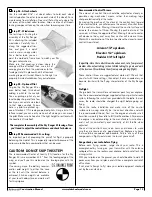
Page 8
www.oldschoolmodels.com
Construction Manual
Step 43 - Fuselage Assembly (F3 and TR1 installation)
Locate F3 from LP4 and TR1 from
LP3. Glue both of these in place
on the right side of the fuselage as
shown here.
Step 44 - Fuselage Assembly (TR2 installation)
Locate TF2 from LP3 and glue it
in position as shown. Note the
orientation of TR2 so the servo holes
are towards the rear of the plane.
Step 45 - Fuselage Assembly (F5 installation)
Locate F5 from LP4. Glue it in place as shown
here.
Step 46 - Fuselage Assembly (diagonal supports)
Locate WS1 and WS2
from LP1. Glue them
in position as shown,
making sure they line
up perfectly with the
curved opening of the
wing saddle.
Step 47 - Fuselage Assembly (WS3 installation)
Locate WS3 from LP2.
Glue this in place,
notching into R5 and
WS2, already in place.
Step 48 - Fuselage Assembly (WS4 and WS5 installation)
Locate WS4 and WS5 from LP1.
These are laminated together,
making sure to line up the holes
and the sides perfectly line up.
Note that the tabs do not line
up - they’re on opposite sides. Once the glue has set, attach
this assembly to the fuselage side as shown, making sure of it’s
orientation and that it is held vertically as the glue cures.
Step 49 - Fuselage Assembly (Attach left side)
Next up is the attachment of the left side to the fuselage. Trial
fit this next step before applying any glue as there are a lot of
tabs that have to properly fit into the
fuselage side. If using C/A, use a medium
or thick formulation to give you time to fit
everything together. When the left side is
fitted, hold it in position, or place a couple
of weights on it until the glue fully cures.
When cured, remove the fuselage from the
board and run glue as needed to reinforce
all of the wood to wood joints.
Step 50 - Fuselage Assembly (WS2 and WS2 installation)
Locate the remaining WS1 and WS2
pieces from LP1. Attach these in place
to the inside of the left fuselage side.
Step 51 - Fuselage Assembly (WS3 installation)
Locate the remaining WS3 from
LP2. Glue this to the left fuselage
side, similarly as you did on the right
side earlier.
Step 52 - Fuselage Assembly (F6 installation)
Locate F6 from LP4. Glue this in position,
making sure that it’s tabs fit into the fuselage
sides, and that the rear tabs on both WS3
pieces fit into F6.
This piece also is the first spot where the
fuselage starts to taper, so you’ll have to
slightly squeeze the side together for a
correct fit.
Step 53 - Fuselage Assembly (F7, F8 and F9 installation)
Locate F7, F8 and F9 from BP1. Glue these in position one at a
time, working towards the rear. Make sure to evenly squeeze the
fuselage sides together. This will keep the fuselage straight and
true.
Step 54 - Fuselage Assembly (F4 installation.)
Locate F4 from LP4. Glue this in
position.


































